Apr 2010
Mobility Management Innovation
Success route for your mobility project
Ten years ago, the Ministry of Transport, Public Works and Water Management introduced subsidies for mobility projects. Over the past few years, the grants have been awarded through the Mobility Management programme. NL Agency, previously SenterNovem, administered the subsidies. Since then, things have come a long way and a great deal of information has been gathered from the projects that have been submitted. The Mobility Management programme has now come to an end and we need to hold on to the knowledge we have gained. This document sets out 10 lessons gleaned from practical experience. It covers aspects you need to consider when implementing your mobility project. And the do’s and don’ts to bear in mind for a successful mobility project.
Lesson 1: Combine and extend
The bike share system (or OV-fiets) is really nothing more than a hundred-year-old form of transport redesigned for today’s needs. But, in conjunction with an easy to use hire plan, and bikes available for a reasonable price on the right location, the OV-fiets has suddenly become an essential innovatory aspect of our after-transport services. And the mobility package Mobility Mixx is really nothing more than another way of offering travel information and public transport tickets. But it still opens up a world of sustainable travel for business travellers.
The best innovations of the last ten years were often not about innovative travel modalities but a smart way of pairing up or putting existing transportation modes to different uses. Innovations with the best chance of success involve a new organisation or different combination or use of transportation methods. In this way, the Lange Land Ziekenhuis in Zoetermeer combines making a doctor’s appointment online with transport arrangements. Patients who make an appointment on the internet can also organise transport to the hospital right away. Thus preventing a crowded parking area or arriving late for the appointment. The hospital is easier to get to and there’s less likelihood of delayed appointments.
Lesson 2: Forget supply – what’s the demand?
Many people with hire cars want to take the train now and then, but can’t because they have a lease car. Employers often feel it is too complicated and too expensive to offer other forms of transport as well. Mobility Mixx saw a gap in the market, and jumped in by acting as “service provider” on behalf of the employer. It has become a successful innovation because it meets a clear need.
Travellers want to get from A to B in comfort, and on time. At what point do travellers come into contact with your innovation? And what, at that particular point, are their needs? If this need doesn’t dovetail with your idea, reconsider the project. Carpooling never got off the ground because many innovators weren’t entirely clear about what people considered disadvantages: fear of social dangers, unwillingness to make detours (a frequent occurrence in the Netherlands) and the fact that many people far prefer driving alone.
Lesson 3: Look at the total range of activities
The company Besite created Tripticket, a website where users can book tickets for events, and the transport there and back, in one go. The traveller is thus encouraged to think about transportation beforehand, and make arrangements sooner. The combination of ticket, information and transport is making Besite a great success.
You might have devised a brilliant system, but it doesn’t end there. Your project or idea is just one small part of a larger whole. And more is needed to communicate your idea to the traveller. Take travel information systems, for instance. Information has to be gathered, processed and disseminated. And all these processes involve different parties. Good partnerships and the effective realisation of all those activities add to the value of your project and give you a competitive edge. Look at the example of Tripticket cited above. And the reverse is also true. Without good transportation there and back your innovative public transport project won’t be much of a success. Look at all the activities needed to make your project work well. Where is your project in all this? What makes it so unique? What other factors is your project dependent on? How can you enhance your project’s value through good partnerships? Make a sound strengths and weaknesses analysis. And avoid any nasty surprises later.
Lesson 4: The public transport world offers concessions
Many companies have ideas for great public transport services. At NL Agency there have been ‘flying buses’ and numerous projects mixing individual and collective transport. It wasn’t common knowledge that the public transport sector offers concessions.
The Passenger Transport Act 2000 (Wet Personenvervoer 2000) is in force in the Netherlands. Transport authorities offer a transport company a concession to provide public transport in their area, based on a set of criteria. A new service must meet those specifications. Apart from the question of whether some projects are technically feasible, and whether they have a target group, a new public transport idea must be analysed to see if it fits into the concession system.
If you have a new idea for public transport you need to be sure that it complies with the published specifications and discuss it with the transportation authority (at provincial or city level) at an early stage.
Lesson 5: Concessions come to an end
Hermes developed “Infotin”, a bus stop information system, which was successfully carried out in Limburg. It was well received in Almere, Eindhoven and Leeuwarden too. However, other regions worked to slightly different requirements and these “Infotins” didn’t get off the ground. When a different transport company began in Limburg, the “Infotin” disappeared from this region, too.
In the Netherlands, regional concessions for public transport are tendered every four to five years. A newly developed mobility project must be in line with a concession for public transport or target group transport, within the set statutory frameworks. And this is often the seat of the problem. Innovations frequently get left behind if concessions pass from one transport body to another. A new tender can, for example, result in a different transport company and different priorities. Transporters are not quick to invest in ideas if the results are only visible once the current concession has ended. After all, they’re not sure they’ll reap the benefits of it. What’s more, a project that succeeds in one region probably doesn’t fit easily, if at all, into a transport concession elsewhere in the country.
Fortunately, concessions are taking a number of mobility innovations into account more often. Nevertheless it is crucial to adhere to (existing) standards. This will prevent your innovative mobility project from overreliance on the duration of concessions.
Lesson 6: Be aware of existing agreements and how the money flows
Millennium Transport International developed a flexible bus system with the residents of medium-sized cities like Weert and Hoogeveen. The project failed. The bus collective bargaining agreement didn’t fit the bus drivers’ work rotas. And the existing counting method was unable to give an accurate idea of the number of extra passengers this flexible city bus could transport, in addition to the current city bus. A promising initiative thus went to waste.
Your public transport system may work beautifully but you’re in trouble if you don’t know in advance whether your system fits into existing structures (not only the collective bargaining agreement but the agreements made between the province and transport company). So make sure that your mobility project is in line with current agreements and that your project can survive without a subsidy. Making a business case of this nature often calls for more creativity than you might expect. But there are lots of options. An employer might, for instance, be very flexible about mileage and can decide how to allocate it. The Trappers project put this to great use and devised a unique bike incentive and rewards system to promote cycling to and from work. And more can be done in other areas. People often don´t like to pay just for travel information. But if you can integrate this information into an events transportation package, this “free information” is affordable. Which is exactly what Tripticket did.
Lesson 7: Double your planning
A bike shelter like the Velominck was designed as early as 2001. The first did not open until 2005 because of the sheer number of permits that needed to be applied for. A process that also turned out to be more complicated than expected.
Many innovators have a corporate background and are used to developing an idea and putting it rapidly into operation. But making a project operational often takes a lot of time and could require permits. This is why your planning should factor in a longer implementation time. This will ensure its smooth introduction. In our experience, 90% of the plannings are too optimistic. So make sure yours is realistic.
Lesson 8: Know your target group
Design bikes are cool. And often pretty expensive. Raptobike was founded by a guy who is passionate about recumbent cycling. He realised that the price and long delivery time were putting people off buying recumbent bikes. So he developed a successful, far cheaper cycle that focuses on the essentials elements, comfort, and an attractive price. And is deliverable within a week.
This example shows that you need to know your target group and that the parties involved in the decision to take the project further, know what to expect. This is clear from the numerous studies of the Peoplemovers project, earlier this century. Everyone was in favour until it was time to pay. The project was scrapped. So what is your market? Do you have a thorough knowledge of the group interested in using your bike shelter or information system? Can you get that across clearly to potential investors?
In short, you need to know who will be taking your project further once it has been developed.
Lesson 9: Timing is everything!
Thirty years after the white bike scheme, the bike share system (or OV-fiets) and various other bike sharing projects sprang up.
Make sure the timing is right for your project. Know your market and your target group. Look at technological developments, too. Ideas that didn’t work in the past can be a great success later on. Look at the public bike system.
An idea may be perfect but if the time or the market aren’t ready, it destined for failure. So respond to market demand and make use of new technological advances like the GPS location finder for travel information services.
Lesson 10:Get more support than just the director
The municipality of Haarlem and companies at the business park in Waarderpolder wanted to make the area more accessible. Everything seemed in place but the collective transport option offered by Zero Friction Mobility was underused. Employees simply didn’t use it.
Every mobility project fails if there’s not social or political interest. It doesn’t matter whether it’s a government or corporate idea. If a director has no interest in company transport, his employees may think very differently about it. If the plan doesn’t have their support, it will fail. And even if a municipal travel department is passionate about a mobility project it doesn’t mean it has political and social backing. Is the department indulging in hobbyism or does it really have the wherewithal to see something through? So be clear on any changes in behaviour that may be required, and why. Simply offering a cost-effective plan isn’t enough. You need a raft of incentives and disincentives to really make change work.
Ten years ago, the Ministry of Transport, Public Works and Water Management introduced subsidies for mobility projects. Over the past few years, the grants have been awarded through the Mobility Management programme. NL Agency, previously SenterNovem, administered the subsidies. Since then, things have come a long way and a great deal of information has been gathered from the projects that have been submitted. The Mobility Management programme has now come to an end and we need to hold on to the knowledge we have gained. This document sets out 10 lessons gleaned from practical experience. It covers aspects you need to consider when implementing your mobility project. And the do’s and don’ts to bear in mind for a successful mobility project.
Lesson 1: Combine and extend
The bike share system (or OV-fiets) is really nothing more than a hundred-year-old form of transport redesigned for today’s needs. But, in conjunction with an easy to use hire plan, and bikes available for a reasonable price on the right location, the OV-fiets has suddenly become an essential innovatory aspect of our after-transport services. And the mobility package Mobility Mixx is really nothing more than another way of offering travel information and public transport tickets. But it still opens up a world of sustainable travel for business travellers.
The best innovations of the last ten years were often not about innovative travel modalities but a smart way of pairing up or putting existing transportation modes to different uses. Innovations with the best chance of success involve a new organisation or different combination or use of transportation methods. In this way, the Lange Land Ziekenhuis in Zoetermeer combines making a doctor’s appointment online with transport arrangements. Patients who make an appointment on the internet can also organise transport to the hospital right away. Thus preventing a crowded parking area or arriving late for the appointment. The hospital is easier to get to and there’s less likelihood of delayed appointments.
Lesson 2: Forget supply – what’s the demand?
Many people with hire cars want to take the train now and then, but can’t because they have a lease car. Employers often feel it is too complicated and too expensive to offer other forms of transport as well. Mobility Mixx saw a gap in the market, and jumped in by acting as “service provider” on behalf of the employer. It has become a successful innovation because it meets a clear need.
Travellers want to get from A to B in comfort, and on time. At what point do travellers come into contact with your innovation? And what, at that particular point, are their needs? If this need doesn’t dovetail with your idea, reconsider the project. Carpooling never got off the ground because many innovators weren’t entirely clear about what people considered disadvantages: fear of social dangers, unwillingness to make detours (a frequent occurrence in the Netherlands) and the fact that many people far prefer driving alone.
Lesson 3: Look at the total range of activities
The company Besite created Tripticket, a website where users can book tickets for events, and the transport there and back, in one go. The traveller is thus encouraged to think about transportation beforehand, and make arrangements sooner. The combination of ticket, information and transport is making Besite a great success.
You might have devised a brilliant system, but it doesn’t end there. Your project or idea is just one small part of a larger whole. And more is needed to communicate your idea to the traveller. Take travel information systems, for instance. Information has to be gathered, processed and disseminated. And all these processes involve different parties. Good partnerships and the effective realisation of all those activities add to the value of your project and give you a competitive edge. Look at the example of Tripticket cited above. And the reverse is also true. Without good transportation there and back your innovative public transport project won’t be much of a success. Look at all the activities needed to make your project work well. Where is your project in all this? What makes it so unique? What other factors is your project dependent on? How can you enhance your project’s value through good partnerships? Make a sound strengths and weaknesses analysis. And avoid any nasty surprises later.
Lesson 4: The public transport world offers concessions
Many companies have ideas for great public transport services. At NL Agency there have been ‘flying buses’ and numerous projects mixing individual and collective transport. It wasn’t common knowledge that the public transport sector offers concessions.
The Passenger Transport Act 2000 (Wet Personenvervoer 2000) is in force in the Netherlands. Transport authorities offer a transport company a concession to provide public transport in their area, based on a set of criteria. A new service must meet those specifications. Apart from the question of whether some projects are technically feasible, and whether they have a target group, a new public transport idea must be analysed to see if it fits into the concession system.
If you have a new idea for public transport you need to be sure that it complies with the published specifications and discuss it with the transportation authority (at provincial or city level) at an early stage.
Lesson 5: Concessions come to an end
Hermes developed “Infotin”, a bus stop information system, which was successfully carried out in Limburg. It was well received in Almere, Eindhoven and Leeuwarden too. However, other regions worked to slightly different requirements and these “Infotins” didn’t get off the ground. When a different transport company began in Limburg, the “Infotin” disappeared from this region, too.
In the Netherlands, regional concessions for public transport are tendered every four to five years. A newly developed mobility project must be in line with a concession for public transport or target group transport, within the set statutory frameworks. And this is often the seat of the problem. Innovations frequently get left behind if concessions pass from one transport body to another. A new tender can, for example, result in a different transport company and different priorities. Transporters are not quick to invest in ideas if the results are only visible once the current concession has ended. After all, they’re not sure they’ll reap the benefits of it. What’s more, a project that succeeds in one region probably doesn’t fit easily, if at all, into a transport concession elsewhere in the country.
Fortunately, concessions are taking a number of mobility innovations into account more often. Nevertheless it is crucial to adhere to (existing) standards. This will prevent your innovative mobility project from overreliance on the duration of concessions.
Lesson 6: Be aware of existing agreements and how the money flows
Millennium Transport International developed a flexible bus system with the residents of medium-sized cities like Weert and Hoogeveen. The project failed. The bus collective bargaining agreement didn’t fit the bus drivers’ work rotas. And the existing counting method was unable to give an accurate idea of the number of extra passengers this flexible city bus could transport, in addition to the current city bus. A promising initiative thus went to waste.
Your public transport system may work beautifully but you’re in trouble if you don’t know in advance whether your system fits into existing structures (not only the collective bargaining agreement but the agreements made between the province and transport company). So make sure that your mobility project is in line with current agreements and that your project can survive without a subsidy. Making a business case of this nature often calls for more creativity than you might expect. But there are lots of options. An employer might, for instance, be very flexible about mileage and can decide how to allocate it. The Trappers project put this to great use and devised a unique bike incentive and rewards system to promote cycling to and from work. And more can be done in other areas. People often don´t like to pay just for travel information. But if you can integrate this information into an events transportation package, this “free information” is affordable. Which is exactly what Tripticket did.
Lesson 7: Double your planning
A bike shelter like the Velominck was designed as early as 2001. The first did not open until 2005 because of the sheer number of permits that needed to be applied for. A process that also turned out to be more complicated than expected.
Many innovators have a corporate background and are used to developing an idea and putting it rapidly into operation. But making a project operational often takes a lot of time and could require permits. This is why your planning should factor in a longer implementation time. This will ensure its smooth introduction. In our experience, 90% of the plannings are too optimistic. So make sure yours is realistic.
Lesson 8: Know your target group
Design bikes are cool. And often pretty expensive. Raptobike was founded by a guy who is passionate about recumbent cycling. He realised that the price and long delivery time were putting people off buying recumbent bikes. So he developed a successful, far cheaper cycle that focuses on the essentials elements, comfort, and an attractive price. And is deliverable within a week.
This example shows that you need to know your target group and that the parties involved in the decision to take the project further, know what to expect. This is clear from the numerous studies of the Peoplemovers project, earlier this century. Everyone was in favour until it was time to pay. The project was scrapped. So what is your market? Do you have a thorough knowledge of the group interested in using your bike shelter or information system? Can you get that across clearly to potential investors?
In short, you need to know who will be taking your project further once it has been developed.
Lesson 9: Timing is everything!
Thirty years after the white bike scheme, the bike share system (or OV-fiets) and various other bike sharing projects sprang up.
Make sure the timing is right for your project. Know your market and your target group. Look at technological developments, too. Ideas that didn’t work in the past can be a great success later on. Look at the public bike system.
An idea may be perfect but if the time or the market aren’t ready, it destined for failure. So respond to market demand and make use of new technological advances like the GPS location finder for travel information services.
Lesson 10:Get more support than just the director
The municipality of Haarlem and companies at the business park in Waarderpolder wanted to make the area more accessible. Everything seemed in place but the collective transport option offered by Zero Friction Mobility was underused. Employees simply didn’t use it.
Every mobility project fails if there’s not social or political interest. It doesn’t matter whether it’s a government or corporate idea. If a director has no interest in company transport, his employees may think very differently about it. If the plan doesn’t have their support, it will fail. And even if a municipal travel department is passionate about a mobility project it doesn’t mean it has political and social backing. Is the department indulging in hobbyism or does it really have the wherewithal to see something through? So be clear on any changes in behaviour that may be required, and why. Simply offering a cost-effective plan isn’t enough. You need a raft of incentives and disincentives to really make change work.
A simple trip abroad
It started so simple
A plane deep into the night
Starting at CPH, landing in TLL
I went to bed
I woke up at the 23rd floor
Seeing this view of Tallinn
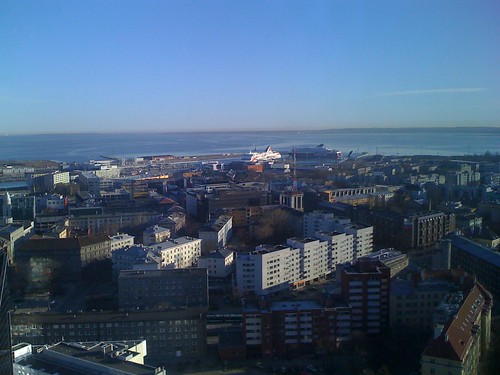
I went to city hall,
To an office without a window,
But with a beautiful soviet era phone
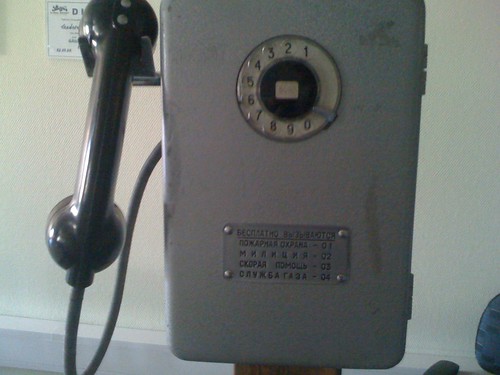
We went to a Datcha
8km out of the city.
Jeroen, our dutch expert arrived.
Bringing the first signs of what was to come
His flight was the last out of Copenhagen
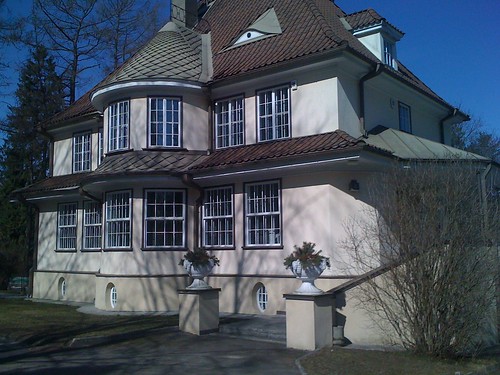
Our Civitas workshop worked effectively
The Slovenians and Estonians
Debating on what ticketing system they would use.
Creative, and Outspoken
As any LFA inspired workshop would like to be.
And then our lovely Estoniuan host surprised us,
By inviting us all to the Sauna.
It would be very rude not to oblige.
And the Saku beer tasted nice
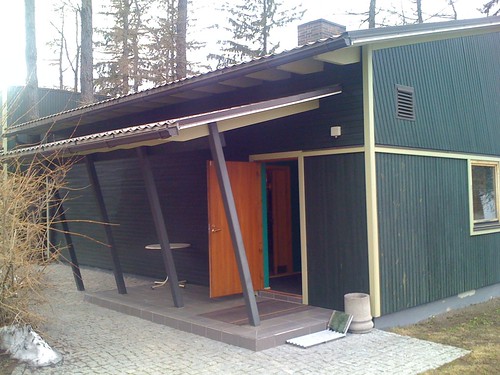
The workshop continued the next day.
But our minded wandered off
To what the Volcano would bring us
We decided to act,
And after some deliberations,
We reserved a place on the Tallink boat to Stockholm.
We had some time to visit the centre of Tallinn,
Looking at its Hanseatic centre, Ancient Reval
As two guys from the city that destroyed that League
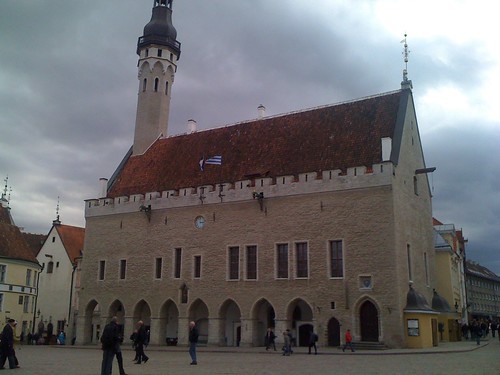
The HMS Victoria gave us a smooth ride
Lovely food, and Cuban dancers.
Before entering Stockholm at is most beautiful
Through the Archipelago
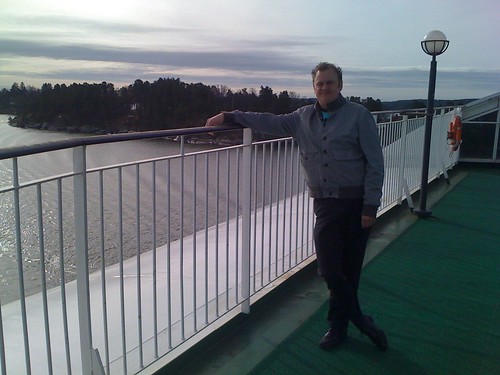
A small trip with the use of Stockholm's ov-chipcard equivalent
Brought us to a crowded T-Centralen.
But a hero from VTI,
Already arranged Tickets to the city of the Mermaid
After a quick coffee with some Swedish friends,
Our X2000 tilted across the Oresund
To an even fuller Københavns Hovedbanegård
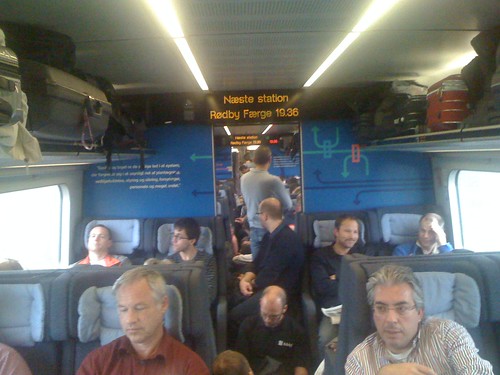
We somehow managed to get in the ready-to-depart train to Hamburg,
And after a quick ferry,
We were pickede up in Oldenburg,
By Gert, another hero in this story,
who brought us back to the United Provinces
All photos
A plane deep into the night
Starting at CPH, landing in TLL
I went to bed
I woke up at the 23rd floor
Seeing this view of Tallinn

I went to city hall,
To an office without a window,
But with a beautiful soviet era phone

We went to a Datcha
8km out of the city.
Jeroen, our dutch expert arrived.
Bringing the first signs of what was to come
His flight was the last out of Copenhagen

Our Civitas workshop worked effectively
The Slovenians and Estonians
Debating on what ticketing system they would use.
Creative, and Outspoken
As any LFA inspired workshop would like to be.
And then our lovely Estoniuan host surprised us,
By inviting us all to the Sauna.
It would be very rude not to oblige.
And the Saku beer tasted nice

The workshop continued the next day.
But our minded wandered off
To what the Volcano would bring us
We decided to act,
And after some deliberations,
We reserved a place on the Tallink boat to Stockholm.
We had some time to visit the centre of Tallinn,
Looking at its Hanseatic centre, Ancient Reval
As two guys from the city that destroyed that League

The HMS Victoria gave us a smooth ride
Lovely food, and Cuban dancers.
Before entering Stockholm at is most beautiful
Through the Archipelago

A small trip with the use of Stockholm's ov-chipcard equivalent
Brought us to a crowded T-Centralen.
But a hero from VTI,
Already arranged Tickets to the city of the Mermaid
After a quick coffee with some Swedish friends,
Our X2000 tilted across the Oresund
To an even fuller Københavns Hovedbanegård

We somehow managed to get in the ready-to-depart train to Hamburg,
And after a quick ferry,
We were pickede up in Oldenburg,
By Gert, another hero in this story,
who brought us back to the United Provinces
All photos
